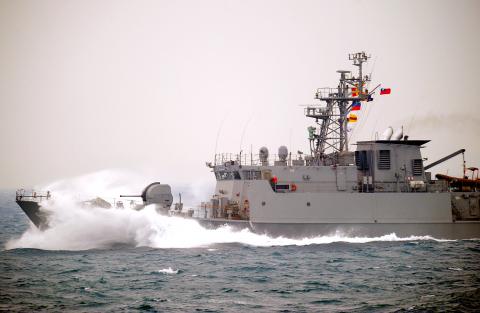The military has begun modifying its fleet of domestically made Ching Chiang-class patrol boats by equipping them with Hsiung Feng III (HF-3) ramjet-powered supersonic anti-ship missiles to counter large surface ships in the Taiwan Strait.
Developed by China Shipbuilding Corp — now known as CSBC Corp, Taiwan — in the 1990s, a total of 11 of the 500 tonne coastal patrol vessels entered service with the navy in 1999 and 2000. The ships were initially equipped with four HF-1 surface-to-surface missiles, one 40mm anti-aircraft gun and one 20mm gun.
In May last year, the Ministry of National Defense unveiled plans to outfit the navy’s eight Cheng Kung-class frigates and a number of Ching Chiang-class vessels with the HF-3, Taiwan’s “aircraft carrier killer” cruise missile developed by the Chungshan Institute of Science and Technology.

Photo: Chang Chung-yi, Taipei Times
Reports yesterday said modification work had begun on seven of the patrol boats, each of which is to be equipped with four HF-3 launchers, and that five Cheng Kung-class frigates had been outfitted with the missile so far as part of a NT$12 billion (US$406 million) program to arm the navy with 120 HF-3s.
A new 500 tonne radar-evasive fast attack corvette, currently at development stage under a project codenamed “Hsun Hai,” or “Swift Sea,” is also expected to be outfitted with eight HF-3s and HF-2s.
Light missile boats like the Ching Chiang, Hsun Hai and the 170 tonne Kuang Hua VI-class vessels launched in recent years are part of ongoing efforts to create an asymmetrical capability to counter China’s increasingly powerful navy. Relatively slow destroyers and frigates with heavy displacement, including aircraft carriers, are seen as particularly vulnerable to asymmetrical strategies.
Although ministry sources have confirmed plans to deploy land-based HF-3s on the west and east coasts of Taiwan, the ministry denied reports last month that an extended range variant of the missile, currently at 300km, was under development.
A longer-range HF-3 would allow Taiwan to deploy the missiles on the eastern coast and aim them at the Taiwan Strait while using mountainous geography, such as that found in Hualien, as cover from missile attacks by China, thus limiting exposure of the launchers.
The HF-3 entered production in 2010. At least 250 are believed to be in service.

ANOTHER EMERGES: The CWA yesterday said this year’s fourth storm of the typhoon season had formed in the South China Sea, but was not expected to affect Taiwan Tropical Storm Gaemi has intensified slightly as it heads toward Taiwan, where it is expected to affect the country in the coming days, the Central Weather Administration (CWA) said yesterday. As of 8am yesterday, the 120km-radius storm was 800km southeast of Oluanpi (鵝鑾鼻), Taiwan’s southernmost tip, moving at 9kph northwest, the agency said. A sea warning for Gaemi could be issued tonight at the earliest, it said, adding that the storm is projected to be closest to Taiwan on Wednesday or Thursday. Gaemi’s potential effect on Taiwan remains unclear, as that would depend on its direction, radius and intensity, forecasters said. Former Weather Forecast

As COVID-19 cases in Japan have been increasing for 10 consecutive weeks, people should get vaccinated before visiting the nation, the Centers for Disease Control (CDC) said. The centers reported 773 hospitalizations and 124 deaths related to COVID-19 in Taiwan last week. CDC Epidemic Intelligence Center Director Guo Hung-wei (郭宏偉) on Tuesday said the number of weekly COVID-19 cases reported in Japan has been increasing since mid-May and surpassed 55,000 cases from July 8 to July 14. The average number of COVID-19 patients at Japan’s healthcare facilities that week was also 1.39 times that of the week before and KP.3 is the dominant

The Chinese Communist Party’s (CCP) working group for Taiwan-related policies is likely to be upgraded to a committee-level body, a report commissioned by the Mainland Affairs Council (MAC) said. As Chinese President Xi Jinping (習近平) is increasingly likely to upgrade the CCP’s Central Leading Group for Taiwan Affairs, Taiwanese authorities should prepare by researching Xi and the CCP, the report said. At the third plenary session of the 20th Central Committee of the CCP, which ended on Thursday last week, the party set a target of 2029 for the completion of some tasks, meaning that Xi is likely preparing to

US-CHINA TRADE DISPUTE: Despite Beijing’s offer of preferential treatment, the lure of China has dimmed as Taiwanese and international investors move out Japan and the US have become the favored destinations for Taiwanese graduates as China’s attraction has waned over the years, the Ministry of Labor said. According to the ministry’s latest income and employment advisory published this month, 3,215 Taiwanese university graduates from the class of 2020 went to Japan, surpassing for the first time the 2,881 graduates who went to China. A total of 2,300 graduates from the class of 2021 went to the US, compared with the 2,262 who went to China, the document showed. The trend continued for the class of 2023, of whom 1,460 went to Japan, 1,334 went to